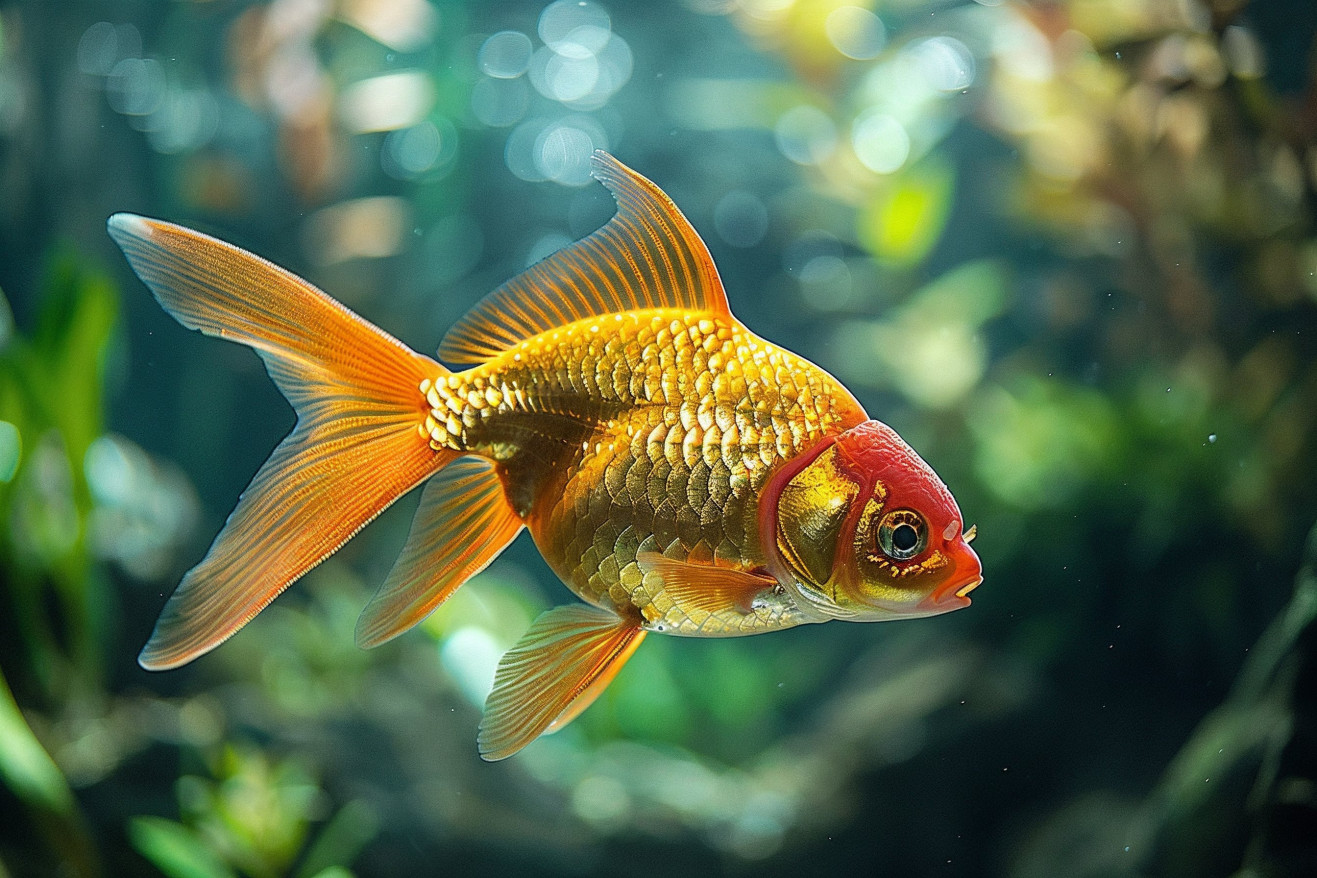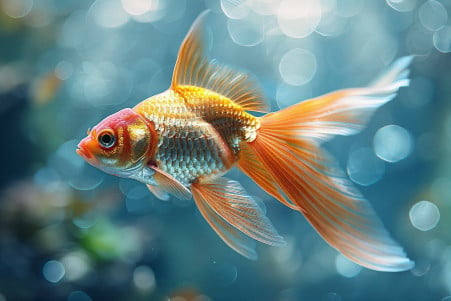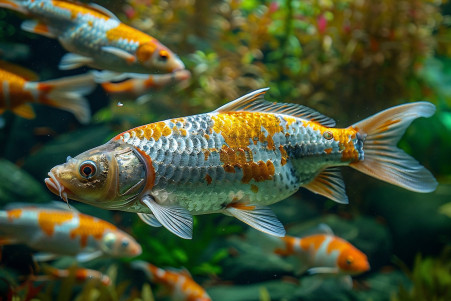How Big Do Goldfish Get? The Factors That Determine Their Size
23 February 2024 • Updated 21 February 2024

Despite their common association with small fishbowls, goldfish have an impressive growth potential when given the right environment. Depending on the type, goldfish can grow to be quite large; single-tail varieties can grow to be 12–14 inches long, while double-tail varieties usually grow to be 6–8 inches long. The largest goldfish on record was an astounding 18.7 inches. However, to reach their full potential, goldfish need enough room, good water quality, and a healthy diet.
This article will cover scientific research and expert insights from the fields of biology, aquarium sciences, and environmental science. It will cover genetic limitations, the effect of living conditions on growth, and the relationship between diet and size.
By exploring these topics, you’ll walk away with a thorough understanding of the factors that determine how big a goldfish will get and how you can create the best environment to ensure they grow to their full size.
How big do goldfish get?
The Genetic Basis of Goldfish Growth
The ultimate size that a goldfish can reach is determined by a combination of genetic and environmental factors. Over the course of thousands of years, goldfish breeders have used artificial selection to create a wide variety of strains, each with its own potential for growth.
A study published in the International Journal of Molecular Sciences found that artificial selection has had a major impact on the gene expression of goldfish, especially in the Celestial-Eye and Ryukin strains. These genetic differences have been driven by the selective breeding of goldfish to emphasize certain ornamental traits, including body size.
A study published in ScienceDirect demonstrated that transposable elements and whole-genome duplication have played a role in generating the morphological diversity seen in domesticated goldfish and identified genetic loci associated with specific phenotypes, suggesting that the selection of goldfish with different body shapes and sizes is a direct result of the fish’s genetics.
In addition, a study published in PNAS traced the evolutionary history and domestication of goldfish and found that genome duplication and mutations have contributed to the fish’s size and shape. While intrinsic genetic factors determine a goldfish’s potential for growth, environmental factors also determine how much of that potential is realized, and this is an important part of the goldfish growth equation.
Important Environmental Factors That Affect How Big Goldfish Get
The size of the tank and the quality of the water are two of the most important factors that determine how big a goldfish will get.
However, as we look at the many factors that influence goldfish size, we find that one of the most important things for goldfish to grow to their full potential is plenty of space.
While many people believe that goldfish grow to the size of their tank, Pets on Mom points out that it’s not the size of the tank but the poor water quality that comes with small tanks that stunts their growth. This is because goldfish release growth-inhibiting hormones, such as gamma-aminobutyric acid, when they’re stressed, which leads to stunted growth, a concept that Cosmos explains.
Goldfish need a healthy environment to grow as big as they can. Fishkeeping suggests that common goldfish need at least a 40-gallon tank, with an additional 12 gallons for each additional fish, and a tank that’s at least 4 feet long to make sure they have enough room to swim.
Fancy goldfish need slightly smaller tanks. These tank sizes mimic the larger spaces of their natural habitats, such as ponds or lakes, and will allow goldfish to grow to their full size.
By making sure the water is clean, the tank isn’t overcrowded, and the fish have plenty of room to swim, we can make sure goldfish are set up to grow to their full size. We can also make sure they’re ready for another important factor in goldfish growth: their diet.
Nutrition: What a Goldfish Eats
Nutrition plays a key role in a goldfish’s growth. A research article in The Journal of Nutrition showed that feeding goldfish four times a day instead of less often has a positive impact on growth. More frequent feedings lead to a higher specific growth rate in goldfish and improve food conversion efficiency.
The International Journal of Aquatic Fishery (INJAF) emphasizes the importance of a diverse diet, noting that goldfish are omnivores and need both plant and animal-based food.
Goldfish fry need live food to get the protein they need, which shows the importance of a diet that is high in protein, while fancy goldfish, in particular, need a diet that is high in protein for the first six months, according to About Goldfish.
A goldfish’s age and size determine its nutritional needs. Younger fish need to be fed more often and smaller amounts, while adults do best with two feedings a day. It’s best to feed them only as much as they can eat in a few minutes.
However, overfeeding can lead to stunted growth and health problems in goldfish, as well as water quality issues and potential health problems, according to the International Journal of Aquatic Fishery (“INJAF”). A balanced feeding regimen not only impacts the goldfish’s overall size but also impacts its potential for a longer, healthier life, which is directly related to its growth.
Goldfish Longevity and Growth: A Lifespan Perspective
The length of a goldfish’s life is directly tied to its potential for growth. While the average lifespan of a goldfish is 5 to 10 years, with the right care, they can live for over a decade and even up to 20 or 30 years in larger outdoor ponds.
In fact, The Spruce Pets notes that the oldest goldfish on record lived to be 43 years old. This longer lifespan also means a longer period of growth, which gives goldfish more time to grow and reach their full size.
This is especially important when it comes to different goldfish varieties. While common and comet goldfish can live up to 20 years and beyond, the selective breeding of fancy goldfish has led to a shorter lifespan, with many fancy varieties, including Fantails, living between 10 and 15 years. That said, even the more genetically fragile fancy varieties can live more than 15 years if they are well cared for, according to Hepper.
This means that the size of the tank and the quality of the water it holds are important factors in a goldfish’s lifespan. In fact, goldfish can live up to 45 years in the right conditions, which shows just how much a goldfish’s lifespan and growth depend on the care it receives, according to The Goldfish Tank.
Cultivating Leviathans: The Role of Goldfish Care in Their Size
Goldfish care is critical to achieving maximum goldfish size. According to Pets on Mom, water quality is the most important factor; regular water changes and a good filter are necessary to prevent stunting. Oxygen levels are also important, as a well-oxygenated tank will help support a goldfish’s metabolism and growth.
Meanwhile, Fishkeeping World recommends a 40-gallon tank for the first common goldfish, with an additional 12 gallons for each additional fish to ensure they have enough room.
It’s also important to keep an eye on goldfish for signs of disease, which can also stunt their growth. This requires taking care of their needs and watching for signs of illness. Meanwhile, it’s important to encourage responsible pet ownership; goldfish can disrupt local ecosystems if they’re released into the wild and doing so is illegal in many places, according to Fishkeeping World.
By creating a supportive environment for goldfish, pet owners can help ensure that their goldfish reach their potential size and live long, healthy lives. Knowing and following these best practices will help ensure that pet fish can live their best lives and grow into the gentle giants they’re meant to be.
Goldfish Growth Potential in Context
As we wrap up our look at goldfish growth, it’s important to note that the potential for goldfish to grow to impressive sizes is contingent on a variety of factors, including their environment, genetics, diet, and care.
In fact, according to Wikipedia, goldfish can grow up to 18 inches in the wild, a far cry from the small goldfish that are often kept in bowls.
Yet, goldfish’s ability to grow to such large sizes isn’t just a result of their circumstances; as CBS News explains, when goldfish are released into the wild, they can grow to such large sizes that they disrupt ecosystems, highlighting the importance of responsible pet ownership.
We’ve learned that a goldfish’s genetics determine the potential for its growth, but the environment, including the size of the tank or pond and the quality of the water, also plays a big role in determining how big a goldfish will get.
Diet and nutrition are also important factors in a goldfish’s growth, and as Aquarium Source points out, in the right conditions, goldfish can live for 20 years or more, which gives them plenty of time to grow.
That said, it’s important to remember that the role you play in a goldfish’s life is important. If you take care to make sure that your goldfish’s environment is appropriate and that you’re providing the right care, your goldfish can live a long and healthy life and grow to its full potential.
So let’s make sure we’re taking care of our goldfish responsibly and knowledgeably, both for the sake of the fish and the ecosystems they’re a part of.


